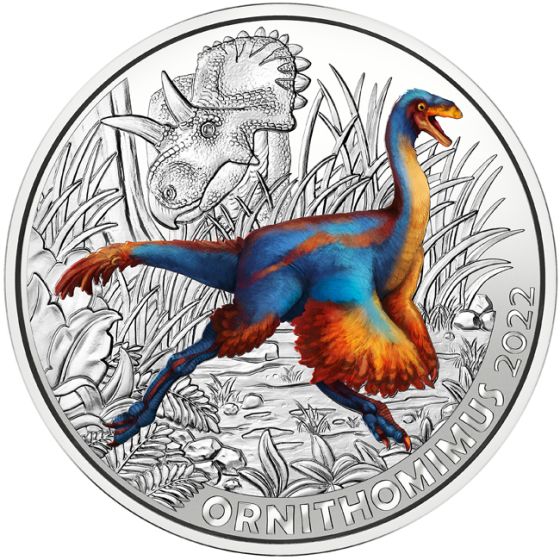Delivery date: Immediate
SKU
01522007
2022 Austria Copper-Nickel 2022 Austria Copper-Nickel Ornithomimus Velox PN PN
Tax:
0%
* excl. shipping
Annotation:
The images displayed are iconic photos.
This product is NOT subject to the right of withdrawal.
| SKU | 01522007 |
|---|---|
| Description | 4 – loose |
| Condition | Newly minted |
| Face Value | EUR 3 |
| Country | Austria |
| Weight (g) | 20.000000 |
| Fine Weight (g) | 0.000000 |
| Material | Copper-Nickel |
| Diameter (mm) | 34 |
| Condition | PN |
| Mintage | 65000 |
| Issue Date | 14.09.2022 |
| Delivery date | Immediate |
Behold the bright and colorful series from the Austrian Mint - Supersaurs! This series brings prehistoric giants back to life in the shape of 12 superb glow-in-the-dark coins.
Coin Highlights:
Cupro-Nickel composition.
Individual coins are packaged in protective packaging.
Mintage of 50,000 coins.
Obverse: Displays a collage of the 12 dinosaurs to be recognized in the series along with the unique €3 denomination.
Reverse: Features a color-printed Ornithomimus moving through a grassy landscape on the coin’s glow-in-the-dark reverse.
Guaranteed by the Austrian Mint.
Protect your colorful Supersaurs coin by adding this capsule to your order.
Add this 2022 Austria Cupro-Nickel €3 Colorful Ornithomimus Velox coin to your cart today!
The fascinating journey to the world of extreme dinosaurs draws to a close in the shape of Ornithomimus velox, the 12th and final coin in the Supersaurs series. Ornithomimus velox is definitely a case of last but not least, however, given that it was the fastest dinosaur to have ever roamed the Earth.
Standing upright on long hind legs that ended in three powerful claws, and with a long, flexible neck and large eyes set in a small head, Ornithomimus velox bore some resemblance to the ostrich, albeit with a long tail and arms instead of wings. The dinosaur even had a toothless jaw that tapered into a beak. Weighing around 150 kilograms and measuring 4 meters from its beak to the tip of its long tail, Ornithomimus had lower legs that were significantly longer than its thighs, and elongated metatarsal bones, both typical characteristics of a fast runner. Computer models have calculated that Ornithomimus had a top speed of 60 to 80 kilometers per hour, but its powerful hind claws suggest that it was capable of defending itself and did not just use its speed to evade attack.
Although the remains found to date cannot exactly substantiate Ornithomimus’ diet, the presence of small gastroliths – stones that birds and other animals swallow to grind food – in the epigastric region of some skeletons imply that it was a herbivore. Having said that, Ornithomimus could also have preyed on small reptiles and insects, another similarity with the ostrich, which despite having a predominantly plant-based diet and employing gastroliths, also eats caterpillars and grasshoppers.

